AMD’s 5 GHz Turbo CPU in Retail: The FX-9590 and ASRock 990FX Extreme9 Review
by Ian Cutress on August 9, 2014 8:00 AM ESTGaming Benchmarks
F1 2013
First up is F1 2013 by Codemasters. I am a big Formula 1 fan in my spare time, and nothing makes me happier than carving up the field in a Caterham, waving to the Red Bulls as I drive by (because I play on easy and take shortcuts). F1 2013 uses the EGO Engine, and like other Codemasters games ends up being very playable on old hardware quite easily. In order to beef up the benchmark a bit, we devised the following scenario for the benchmark mode: one lap of Spa-Francorchamps in the heavy wet, the benchmark follows Jenson Button in the McLaren who starts on the grid in 22nd place, with the field made up of 11 Williams cars, 5 Marussia and 5 Caterham in that order. This puts emphasis on the CPU to handle the AI in the wet, and allows for a good amount of overtaking during the automated benchmark. We test at 1920x1080 on Ultra graphical settings.
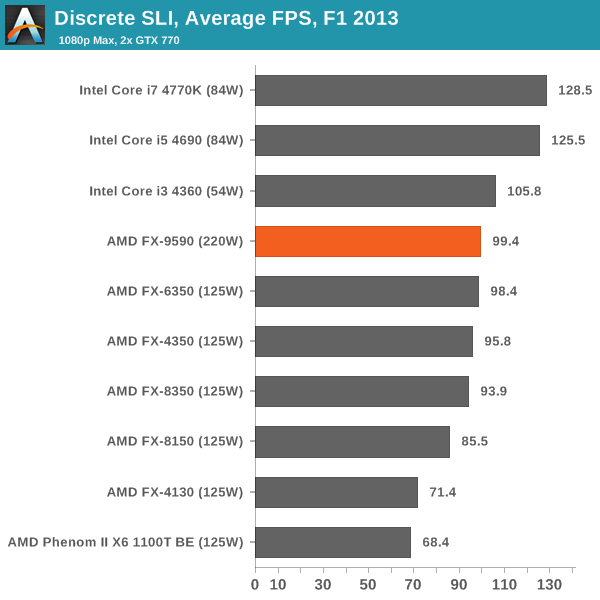
The FX-9590 seems to match the i3-4360, indicating that even more cores, more frequency and more PCIe lanes is not always a good thing. The i3-4360 is using PCIe 3.0 x8/x8, compared to PCIe 2.0 x16/x16 for the FX-9590, which should put them both equal in bandwidth.
Bioshock Infinite
Bioshock Infinite was Zero Punctuation’s Game of the Year for 2013, uses the Unreal Engine 3, and is designed to scale with both cores and graphical prowess. We test the benchmark using the Adrenaline benchmark tool and the Xtreme (1920x1080, Maximum) performance setting, noting down the average frame rates and the minimum frame rates.
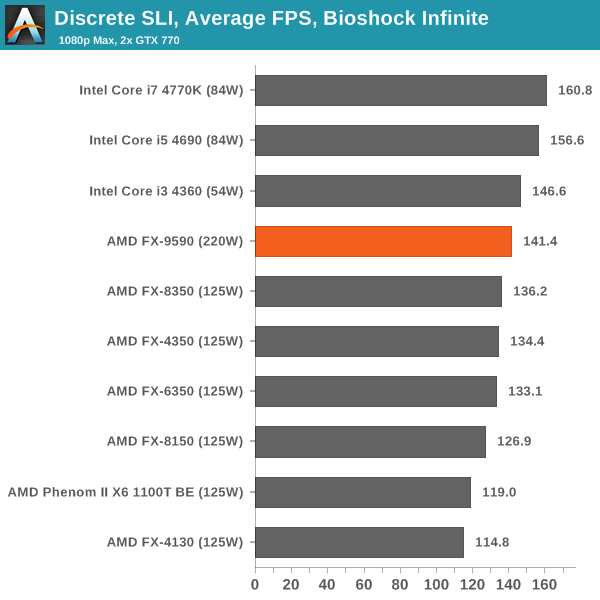
Again, the FX-9590 is trading around the Haswell i3 margin.
Tomb Raider
The next benchmark in our test is Tomb Raider. Tomb Raider is an AMD optimized game, lauded for its use of TressFX creating dynamic hair to increase the immersion in game. Tomb Raider uses a modified version of the Crystal Engine, and enjoys raw horsepower. We test the benchmark using the Adrenaline benchmark tool and the Xtreme (1920x1080, Maximum) performance setting, noting down the average frame rates and the minimum frame rates.
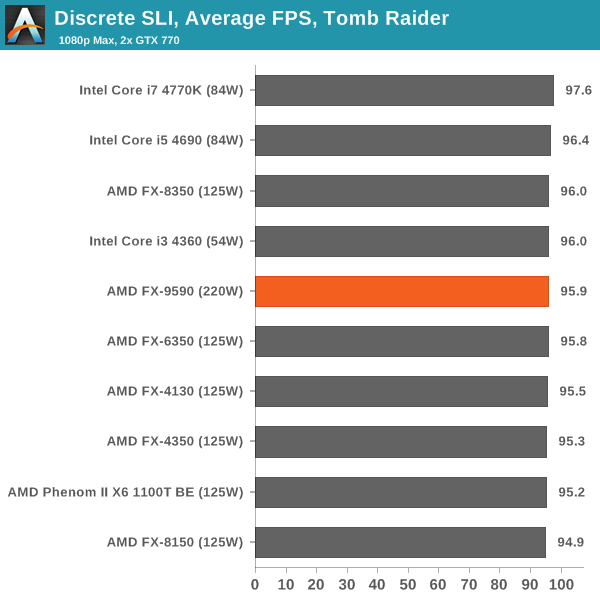
Tomb Raider has historically been CPU agnostic, with all the latest CPUs performing similarly.
Sleeping Dogs
Sleeping Dogs is a benchmarking wet dream – a highly complex benchmark that can bring the toughest setup and high resolutions down into single figures. Having an extreme SSAO setting can do that, but at the right settings Sleeping Dogs is highly playable and enjoyable. We run the basic benchmark program laid out in the Adrenaline benchmark tool, and the Xtreme (1920x1080, Maximum) performance setting, noting down the average frame rates and the minimum frame rates.
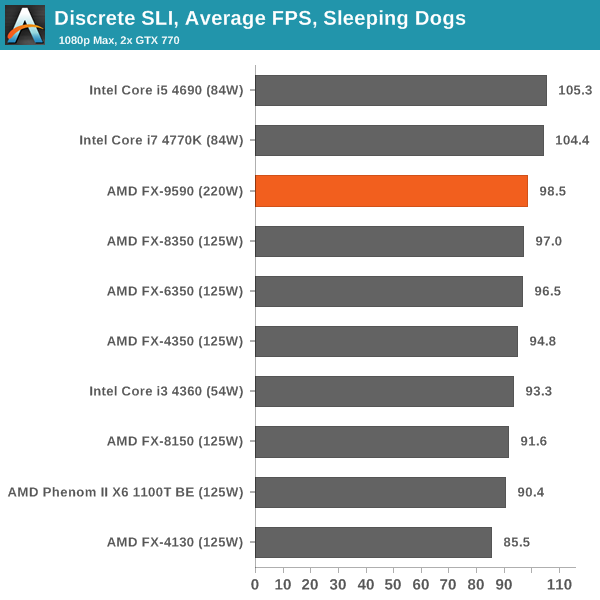
The FX-9590 loses 4-6 FPS on average to the latest Intel cohort, which is not bad considering the release date difference.
Company of Heroes 2
Company of Heroes 2 also can bring a top end GPU to its knees, even at very basic benchmark settings. To get an average 30 FPS using a normal GPU is a challenge, let alone a minimum frame rate of 30 FPS. For this benchmark I use modified versions of Ryan’s batch files at 1920x1080 on High. COH2 is a little odd in that it does not scale with more GPUs with the drivers we use.
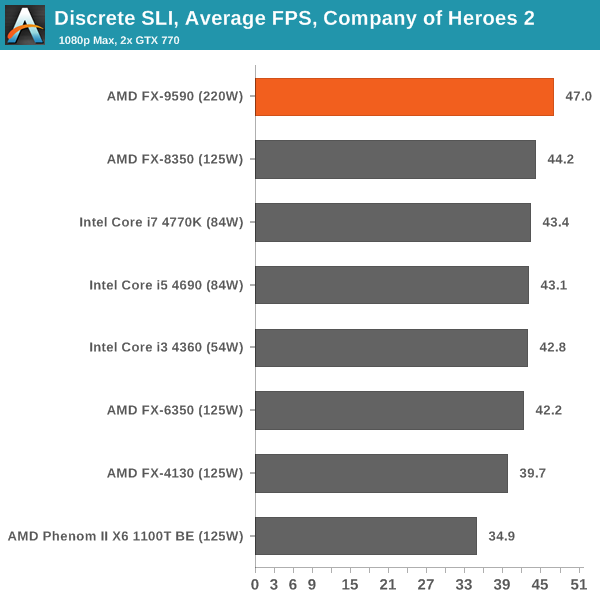
Company of Heroes 2 is usually relatively CPU agnostic except for the older dual core CPUs, but the FX-9590 gets a win here.
Battlefield 4
The EA/DICE series that has taken countless hours of my life away is back for another iteration, using the Frostbite 3 engine. AMD is also piling its resources into BF4 with the new Mantle API for developers, designed to cut the time required for the CPU to dispatch commands to the graphical sub-system. For our test we use the in-game benchmarking tools and record the frame time for the first ~70 seconds of the Tashgar single player mission, which is an on-rails generation of and rendering of objects and textures. We test at 1920x1080 at Ultra settings.
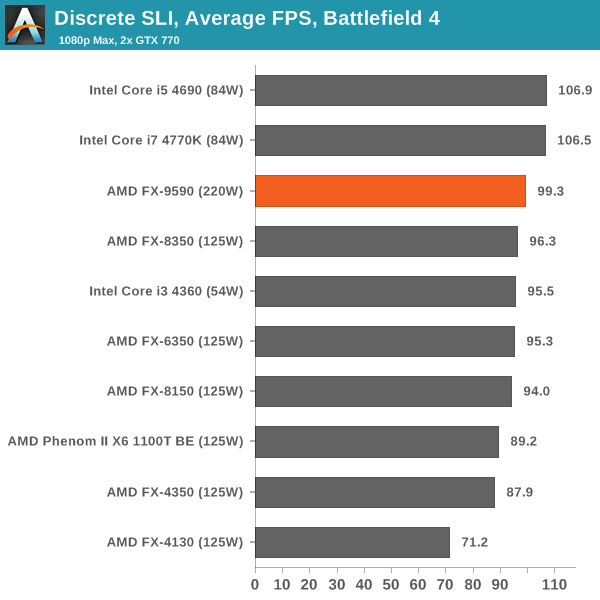
Similar to Sleeping Dogs, the FX-9590 does not lose much considering the release date difference of the architectures.






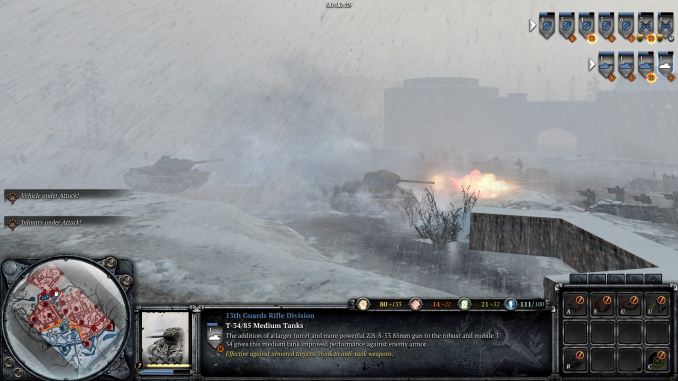









146 Comments
View All Comments
Sushisamurai - Saturday, August 9, 2014 - link
I think you guys are a little too harsh. The architecture was developed 2012-2013, so realistically, this is a sandy bridge/ivy bridge comparison. If you were to OC an ivy bridge/sandy bridge to this performance, you'd be looking at similar wattage (I'm guessing here, 5GHz on ivy/sandy doesn't seem possible on CLC). The fact it comes close to haswell for a year or two old part, I consider that a winDaniel Egger - Saturday, August 9, 2014 - link
Who cares when it was developed to do a comparison. They release it today so it has to compare against todays CPUs and this one sucks on so many levels it's not even funny anymore. Also no sane person cares about clock, it's either single- or multithread performance plus sometimes iGPU performance and of course efficiency, if you want crazy clocks you can dig out some Netburst Pentiums... Last but not least if you desperately want to see this PoC loose in some benchmarks against some mainstream Sandy Bridge CPU then have a look at the graphs and check for "Core i5-2500K".TiGr1982 - Saturday, August 9, 2014 - link
Indeed, clocks comparison does not work in terms of performance comparison between different microarchitectures.One simple number:
Haswell in single thread is around 70% faster (~1.7 times) than Piledriver (say, in Cinebench 1 thread) at the same clocks. ~70%. Check yourself. Nuff said.
Fouquin - Sunday, August 10, 2014 - link
Except they didn't release it today, they released it 14 months ago. So really, it's still an IB - FX comparison. AT was just really slow to put any press on this chips existence. It has no purpose other than to show the limit of the Bulldozer architecture, and it does that quite nicely. (Although I have an FX-8350 running at 5.12, so it isn't even the upper limits.)Really when it comes down to it though, it's a "for fun" chip. Like a super-car: it looks and acts fast, costs way too much, sucks down gas by the gallon, and is complete excess to your needs. But hey, it's shiny and looks good in the garage.
TiGr1982 - Saturday, August 9, 2014 - link
In fact, Sandy Bridge is much more efficient and has much higher IPC than Piledriver. So, Sandy Bridge i7 Core i7-2600K/2700K has to be overclocked around 4.3 GHz to match or surpass FX-9590. Ivy Bridge has slightly better IPC, than Sandy, so that 4.1-4.2 GHz should suffice for Ivy Bridge Core i7-3770K to match or surpass FX-9590. And this is for full multithreading.For single threading, Sandy and Ivy are already faster at stock turbo frequencies than anything Piledriver can offer. Piledriver has to be clocked beyond 6 GHz to try to match Core i7 stock single thread (LN2 may help, actually :)).
Yes, single-threaded performance is not so important these days, as many people like to point out, but lack of single-threaded performance is still a considerable drawback.
Sushisamurai - Saturday, August 9, 2014 - link
Yes, I realized clock to clock comparison doesn't really work - it would work if IPC was similar between different micro architectures... and well... I was over simplifying things. But, on the benchmarks, this FX core does seem to catch up to the i7-2500.My main point was to emphasize that this CPU has been around for a while, and was only recently "released" to the general public as opposed to OEM's. Had this been available when it was developed, it might have made a bigger difference for AMD - which could have potentially kept them in the CPU race.
TiGr1982 - Saturday, August 9, 2014 - link
Well, to make a bigger difference, it had to be WIDELY released a year ago (say, around initial Haswell release) for, say, $250-280 (and not $350) for retail, and be supported immediately with at least 5-7 new MOBOs capable of working with 220W TDP out of the box. Since it did not happen, now it is maybe "too little, too late" - especially, considering the facts, that:1) Devil's Canyon Core i7-4790K is already on sale, and it costs the same $$$ as last year's Core i7-4770K. Core i7-4790K is even further ahead of FX-9590 in terms of performance at stock (4.0-4.4 Ghz) and i7-4790K is even a little further overclockable to around 4.5-4.6 GHz with no issues, and FX-9590 is actually not.
2) Haswell-E is coming, and the cheapest Haswell-E, rumored to be Core i7-5820K, is supposed to have 6 Haswell cores and cost something around $400. This is of course worth thinking about for the people getting/building a new desktop machine.
mapesdhs - Tuesday, August 12, 2014 - link
Alas AFAIK the 5820K is a 4-core. 5930K is 6-core, 5960X is 8-core.
Ian.
TiGr1982 - Wednesday, August 13, 2014 - link
Not really; so far, all the sources point that Core i7-5820K will be 6 core - unlike Core i7-4820K and Core i7-3820 before it.mapesdhs - Tuesday, August 12, 2014 - link
SB is such a nice chip. Every 2700K I've obtained has happily run at 5GHz no problem,takes just a few minutes on a board like the ASUS M4E/Z. Built five of them so far. And
unlike the latest HW, it won't throttle because the temps are still good.
Ian.